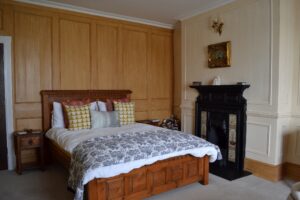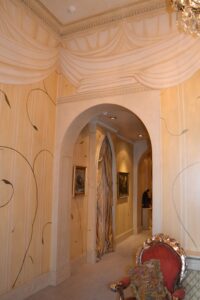02 Nov Faux finishes for walls
Faux is another french word borrowed by the English translated as literally ‘ false’ as
part of a fancify terminology of the art of creating a painted finish on a wall which
imitates real-life substances as wood or marble, sometimes called ‘specialist finishes’.
Although it is difficult to determine exactly when the first faux painting came about it is
evident in Greek and Roman art when it was used to imitate marble and also exotic
stones when it was impractical or too expensive to use the real thing.
The decorative arts enjoyed a resurgence in the 18th century when marble imitation
(marbling) and wood imitation (wood graining) was in use throughout Europe especially
Italy and France in grand country houses and palaces, along with murals and gold
gilding.
It became part of a skilled decorative painter’s arsenal and in the UK was kept alive by
the use in public houses, restaurants, and the occasional grand home but not with the
general public where wallpaper offered a cheaper alternative.
As with many fads, the decorative arts and faux finishes for walls enjoyed a popular
the resurgence in the 1980s where the discerning public was yearning for the warm earth
colors of Italy and Siena and broken wall finishes were the big things.
It was during this time when new faux finishes were appearing on walls with names like
‘ragging’ (applied paint distressed with a rag) ‘sponging’ (paint applied by sponge)
‘stippling’( applied paint manipulated by a specialist brush) ‘washes’ a thin glaze paint
washed onto the walls, not to mention the old favorites‘ marbling’ and ‘wood graining’.
The demand was big enough that the new company’s started up to create new products to
make it easier to create faux finishes taking it out of the domain of trained specialist
decorators and many enthusiastic homeowners tried their hand with varying results.
The fashion has changed with a hand full of more skilled decorators still using the
traditional techniques which, I, as a practicing muralist and decorative artist find very
useful, and mix the use of faux finishes with trompe l’oeil painting as part of my
decorative arsenal.
At present we are at a very eclectic period of decoration, expensive hand-printed
wallpaper has replaced murals on feature walls and has got so exclusive that it is often
less expensive for clients to commission a mural artist to do the same work.
During these international eclectic shifts in a decorative fashion, it is useful to be fully
equipped and versatile to be able to do all faux finishes on walls and trompe l’oeil
painting in all styles and any location.







No Comments